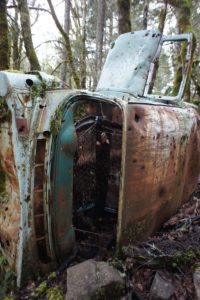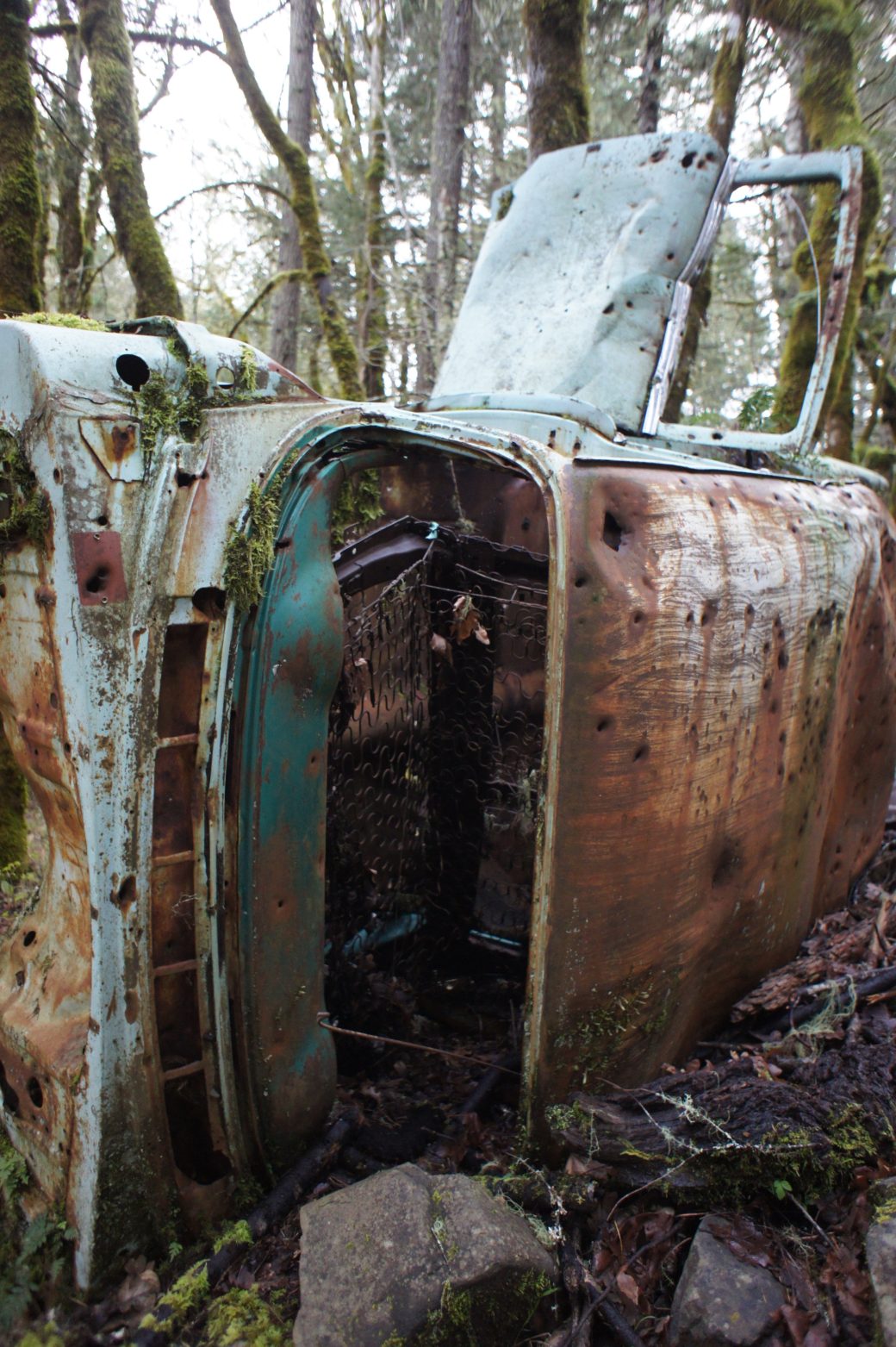
Every place has them: the beautiful objects we walk by every day without noticing; the historical markers we never bother to read; the weird stuff that makes us go “huh?” that we are too busy to investigate.
This week, we’re shining a light on some of these local hidden gems.
Hidden History
Gem No. 1: The Gravestone of John and Euphemia Millar
The Millars couldn’t have known what would happen to their gravestone.
John Millar died in 1836 and is buried in St. Guthbert Churchyard, Edinburgh, Scotland. His wife, Euphemia, died in 1888 in Corvallis at age 87. Together, they are remembered on a handsome, tall tombstone on the north end of Corvallis’ Crystal Lake Cemetery.
This peaceful rest was disturbed during the 1920s when, according to county cemetery manager Leanna Steinke, the Millars’ pillar was hollowed out and used as a drop-off point for exchanging Benjamins and booze during Prohibition.
“Obviously we’ve fixed it,” Steinke was quick to add. “You can’t do that anymore.”
But when we visit the grave, she points to the screws that now secure the plates inscribed with the Millars’ names—and to a cracked corner.
“Somebody must have tried to get in,” she said.
Most ironic, Steinke thinks, is that this boozy rendezvous point shares a resting place with Corvallis Women’s Christian Temperance Union crusader Sara Trago Mitchell, an outspoken critic of calls to repeal the 18th Amendment and end Prohibition.
“It is safe for women to walk down the street now and I should hate to see the old saloon days come back,” Mitchell told the Gazette-Times two weeks before her death, which was just five months before Prohibition was repealed on Dec. 5, 1933.
Unexpected Beauty
Gem No. 2: Constructive Interference at Oregon State University (OSU)
Walk into the towering lobby of OSU’s new Learning Innovation Center and you’ll be greeted by an equally monumental artwork. Constructive Interference is a 30-foot-wide, 17-foot-tall steel and paint construction that takes up nearly an entire wall.
The artwork was created by New York City-based firm Hypersonic, which uses science, technology, and engineering to create artistic and architectural works, and credited to two artists: Jeff Lieberman, who calls himself a “science evangelist” and Bill Washabaugh, who holds a degree in aerospace engineering.
How did two NYC scientist/engineer/artists get hooked up with OSU? Through Oregon Percent for Art, legislation that requires budgets over $100,000 for new public buildings to allocate no less than one percent toward art.
Meaghan Atiyeh, who manages the Percent for Art program for the Oregon Arts Commission, said the program has funded more than 3,000 works since its inception in 1975, and that there are more than 280 Percent for Art works at OSU. To select the artists for Percent for Art projects, art professionals and those intimately connected with the building come together to create a vision, receive proposals, and finally choose an artist. Through the decision-making process, they add a work to this public, distributed art collection.
“It’s all been selected by the citizens,” Atiyeh said of works in the Percent for Art collection. “It’s all by the state and for the state.”
Diane Cooper, an OSU media coordinator, was in the Learning Innovation Center when Constructive Interference was installed.
“One day there wasn’t anything there, and then there it was,” she said.
A video on the building’s website shows the full installation process, and you can see the workers first paint a rust-colored pattern painted directly on the wall, and then cover it with a lattice-like metal frame. In the finished piece, the intersection of the paint and metal patterns creates a sense of movement. The work recalls a three-dimensional child’s spirograph drawing created out of scrapyard metal and turned into a Magic Eye: every time a viewer shifts her gaze, a new pattern emerges. The effect is enchanting and disorienting.
Cooper said her grandson thought this movement was “pretty cool.” Other people say it makes them dizzy. And Cooper? She almost audibly shrugs. “To me, it’s metal. So it’s interesting. Other than that…”
Curious Collections
Gem No. 3: OSU Fisheries and Wildlife Ichthyology Collection
Two scientists and a journalist stand on top of a swimming pool in the basement of OSU’s Nash Hall to look at rows of dead fish in jars.
No, it’s not the beginning of a bad joke, but a tour of OSU’s Ichthyology Collection. Ichthyology is the study of fishes—that’s right, scientists call them fishes, not fish. These jars hold fish and fish larvae collected from all over the world, and the between six and seven thousand gallons of ethanol and isopropyl alcohol used as preservative. So, the “swimming pool” is actually an empty four-foot-deep basin beneath the room, put there to hold the preservative liquid and two hours of sprinkler water in case of a jar-breaking emergency.
The basin was part of a major renovation completed in 2011, which also added new shelving and fishes and digitized the collection. The collection was established in 1935 and has grown to include more than 20,000 jars (known as “lots”) that hold more than 250,000 fishes. Brian Sidlauskas, one of the scientists and OSU associate professor and curator of fishes, said the collection probably has 30,000 lots and millions of specimens, once the un-catalogued lots and fish larvae are considered.
The collection, which is the largest in Oregon and one of the largest on the West Coast, is used for research and teaching. Peter Konstantinidis, the other scientist standing with me in the room, studies fish larvae and acts as curator of vertebrates for the fisheries and wildlife birds and mammals collection. He said that most specimens come from NOAA or other researchers who are sampling—the collection can’t accept a specimen unless it was collected with a collection or fishing permit—but “sometimes people just bring something interesting in.”
Before we left, I asked Konstantinidis to show me his favorite specimen. He laughed and said that he studies larvae, so he thinks they are “the most exciting,” but probably not so fun to look at. Instead, he reached into a bucket and pulled out a “beautiful deep sea angler.”
The fish was maybe the size of your head, if it were mostly flattened. Its mouth stretches from one side to the other, and it has a long antenna-like appendage between its eyes. Konstantinidis said this fully preserved appendage is one of the reasons the fish is special.
He said the specimen is also notable because, well, “the males are parasitic.” He smiled and looked at Sidlaukas, who rephrased it: the males are reduced to “just a sack of gonads.”
“See?” said Konstantinidis, pointing to a two-inch-long protrusion on the fish’s lower half. “The reduced male is still attached.”
Just Plain Strange
Gem No. 4: Fitton Green Car Wreck
The all-caps sign on the Cardwell Road entrance gate to Fitton Green Natural Area reads: “Cardwell Hill Road closed to motorized vehicles ordered by BOC.”
Yet enter the trail on foot, and you’ll soon find the moss-covered wreckage of two definitely-once-motorized vehicles.
The cars look old, like relics from the 1950s, and they lie turned over and wrapped around trees just to the south of the path at the crest of the first hill. One is sun-bleached teal, the color of well-used industrial equipment, and the other dull, sandstone red, but you can imagine they were once shiny and bright, Florida Keys ocean and cherry lollipop cruising down Kings Boulevard like a scene from American Graffiti. Now, a fern grows where one side mirror used to be. Springs that once supported cushions, which supported human butts, support nothing. The doors and roofs are riddled with what appear to be bullet holes.
What happened? Why are these cars here? The mind immediately creates stories: a lover’s tryst fatally interrupted; a testosterone-fueled car chase between betrayed best friends; a gang fight; a drug deal; a dare.
I called the county number posted on the park sign. Leanna Steinke, my cemetery guide, answered the phone. She doesn’t know the cars’ stories. Talk to Ed Easterling, she said. Easterling, who lives next door, didn’t know anything either, but he said he’d ask around. When he called me back a couple hours later, he didn’t have much more to report. People know about the cars, he said, and they say the wreck has been in the woods for decades. Professional photographers have photographed it. People seem to enjoy having it there.
“It’s certainly nostalgia that’s turned into art for which we have no artists,” Easterling said.
For now, the real story remains a mystery.
Have an idea for a hidden gem? Know something more about one of the above mysteries? Email your ideas and comments to [email protected].
By Maggie Anderson
